Impact of Smart Technology Using Drones in Transport and Logistics
VerifiedAdded on 2022/12/26
|6
|1380
|20
Report
AI Summary
This report explores the influence of smart drone technology on the transport and logistics industry, focusing on its positive impacts. It begins with an introduction to drones as smart technology and their applications, particularly within the context of Parcelforce. The report outlines the research methodology, including the use of literature review, and discusses the benefits of drones such as cost savings, safety, and increased business performance. It also addresses the environmental advantages. The study aims to understand the concept of drones, their benefits in the industry, their environmental impact, and the challenges of implementation. The report highlights key publications and themes related to drones, emphasizing their role in enhancing efficiency and sustainability within the transport and logistics sector. The research employs various methodologies, including positivism and questionnaires, to gather and analyze data. The conclusion emphasizes the importance of the research objectives and questions. The report offers insights into the future of drone technology in the industry and its potential for further advancements.
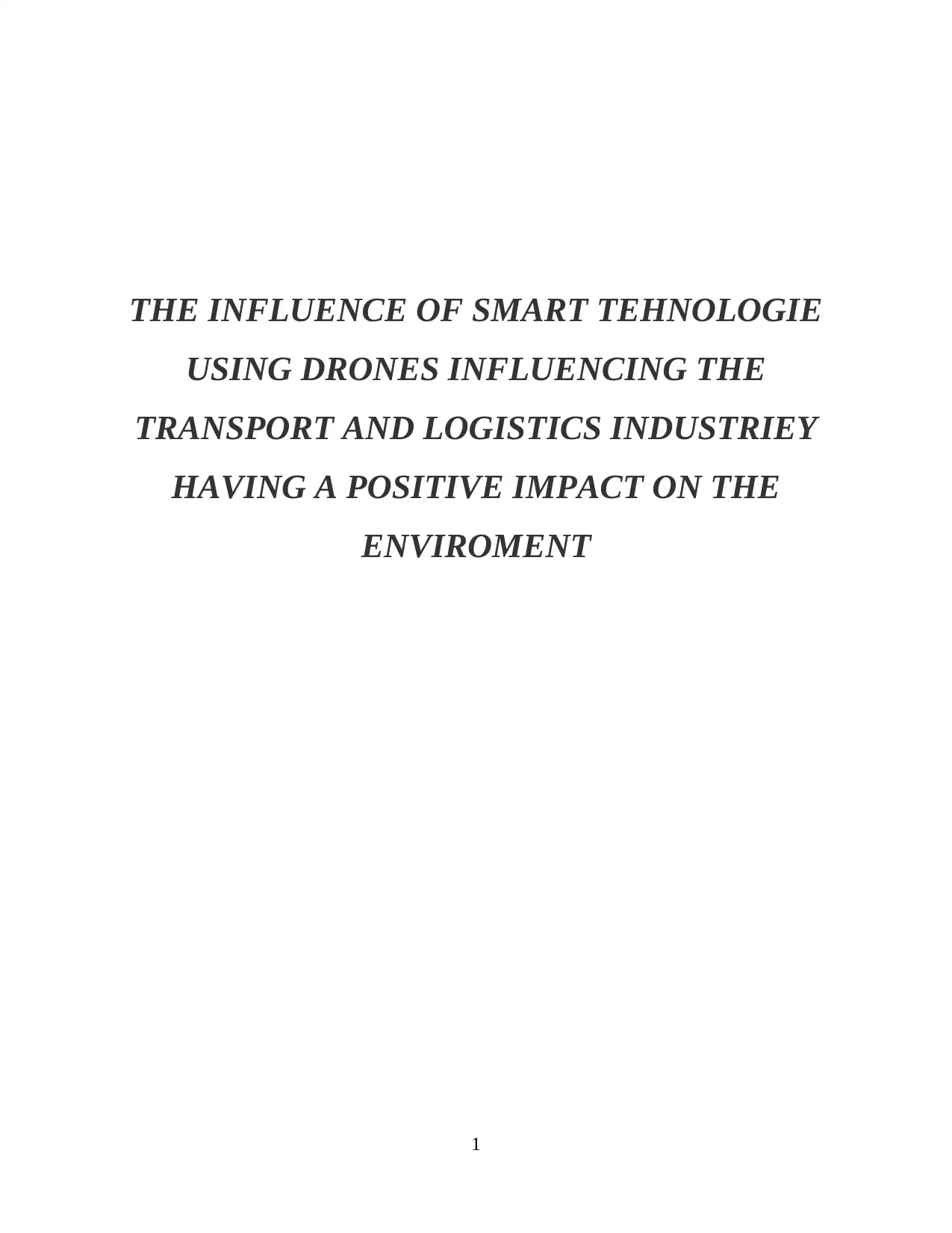
THE INFLUENCE OF SMART TEHNOLOGIE
USING DRONES INFLUENCING THE
TRANSPORT AND LOGISTICS INDUSTRIEY
HAVING A POSITIVE IMPACT ON THE
ENVIROMENT
1
USING DRONES INFLUENCING THE
TRANSPORT AND LOGISTICS INDUSTRIEY
HAVING A POSITIVE IMPACT ON THE
ENVIROMENT
1
Paraphrase This Document
Need a fresh take? Get an instant paraphrase of this document with our AI Paraphraser
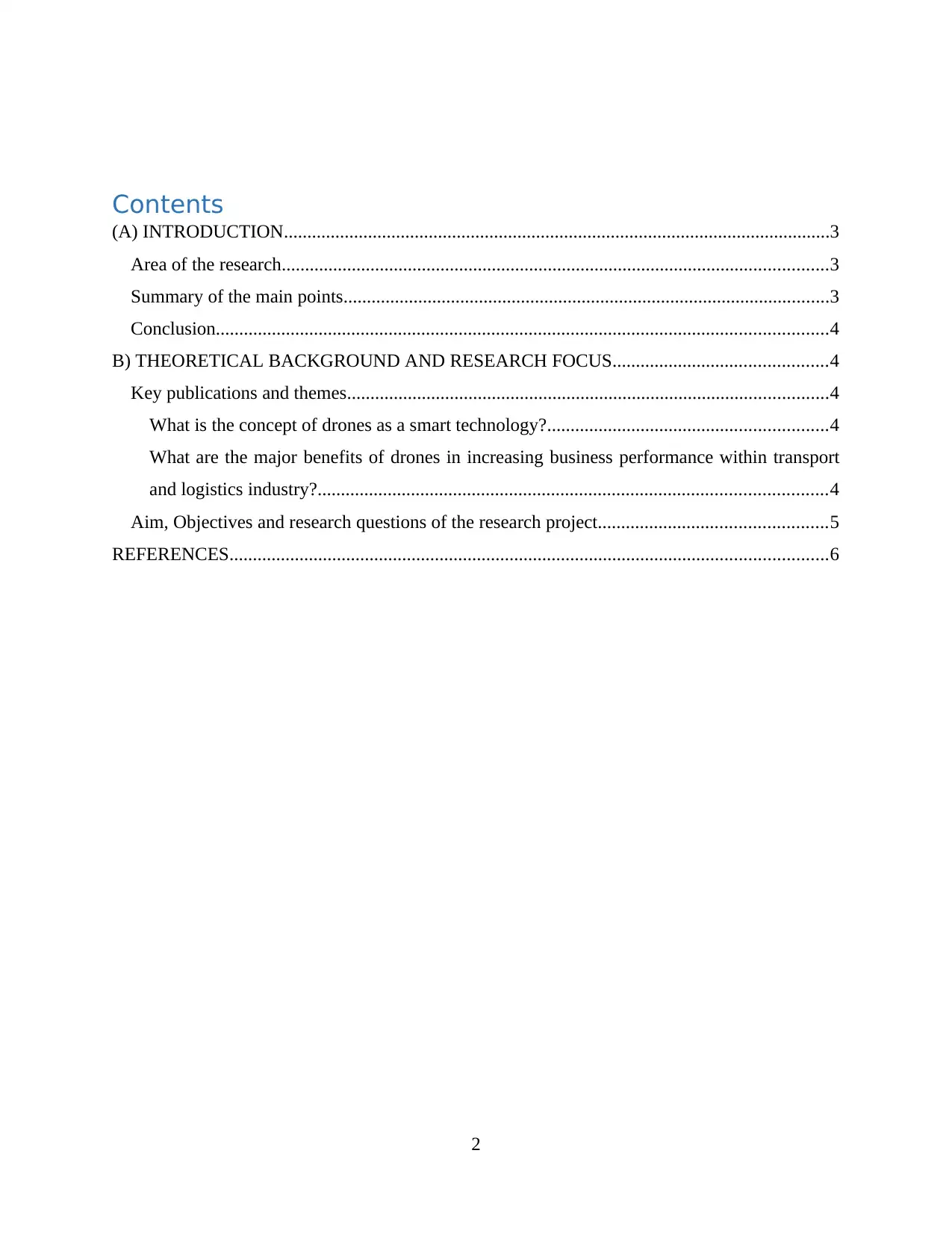
Contents
(A) INTRODUCTION.....................................................................................................................3
Area of the research.....................................................................................................................3
Summary of the main points........................................................................................................3
Conclusion...................................................................................................................................4
B) THEORETICAL BACKGROUND AND RESEARCH FOCUS..............................................4
Key publications and themes.......................................................................................................4
What is the concept of drones as a smart technology?............................................................4
What are the major benefits of drones in increasing business performance within transport
and logistics industry?.............................................................................................................4
Aim, Objectives and research questions of the research project.................................................5
REFERENCES................................................................................................................................6
2
(A) INTRODUCTION.....................................................................................................................3
Area of the research.....................................................................................................................3
Summary of the main points........................................................................................................3
Conclusion...................................................................................................................................4
B) THEORETICAL BACKGROUND AND RESEARCH FOCUS..............................................4
Key publications and themes.......................................................................................................4
What is the concept of drones as a smart technology?............................................................4
What are the major benefits of drones in increasing business performance within transport
and logistics industry?.............................................................................................................4
Aim, Objectives and research questions of the research project.................................................5
REFERENCES................................................................................................................................6
2
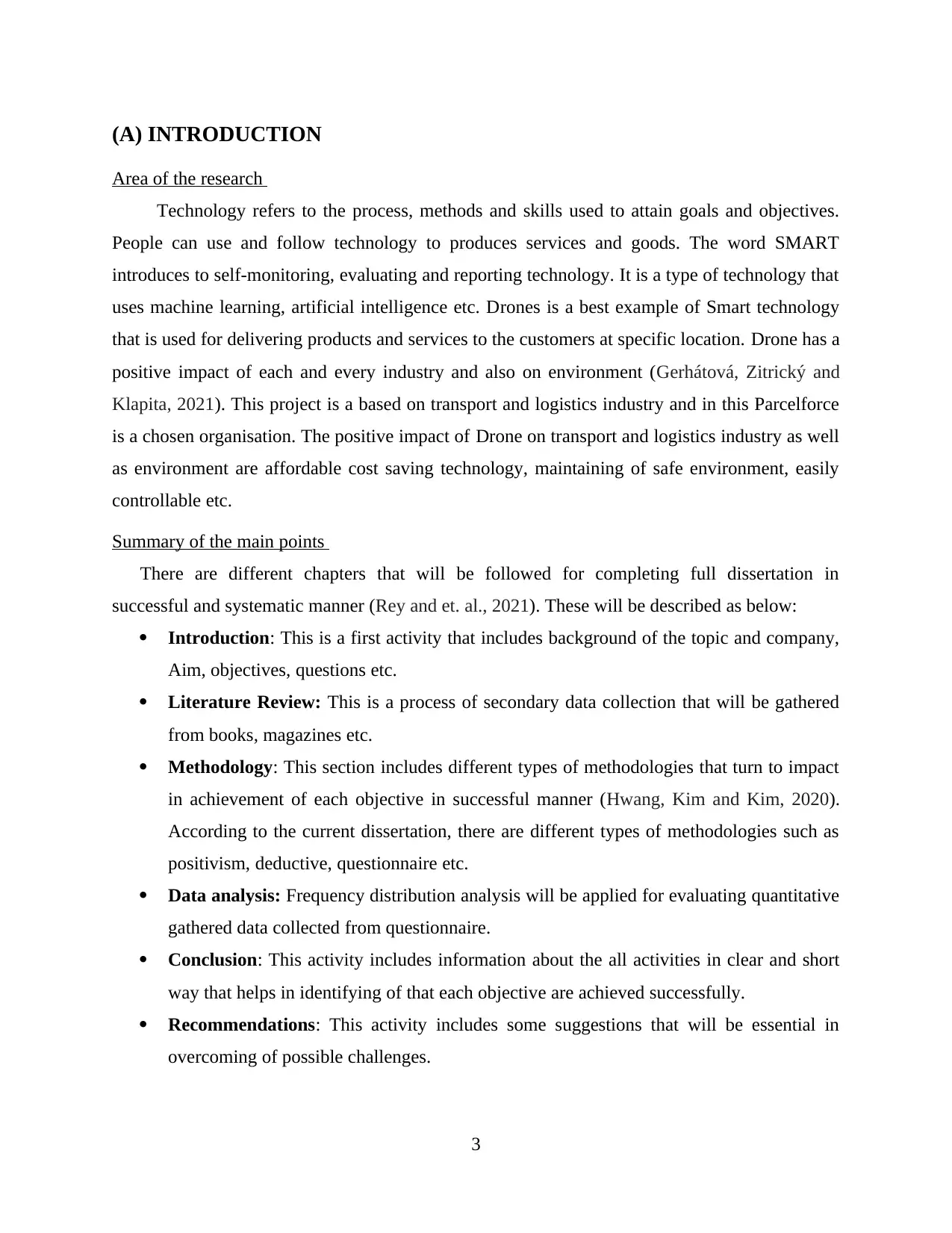
(A) INTRODUCTION
Area of the research
Technology refers to the process, methods and skills used to attain goals and objectives.
People can use and follow technology to produces services and goods. The word SMART
introduces to self-monitoring, evaluating and reporting technology. It is a type of technology that
uses machine learning, artificial intelligence etc. Drones is a best example of Smart technology
that is used for delivering products and services to the customers at specific location. Drone has a
positive impact of each and every industry and also on environment (Gerhátová, Zitrický and
Klapita, 2021). This project is a based on transport and logistics industry and in this Parcelforce
is a chosen organisation. The positive impact of Drone on transport and logistics industry as well
as environment are affordable cost saving technology, maintaining of safe environment, easily
controllable etc.
Summary of the main points
There are different chapters that will be followed for completing full dissertation in
successful and systematic manner (Rey and et. al., 2021). These will be described as below:
Introduction: This is a first activity that includes background of the topic and company,
Aim, objectives, questions etc.
Literature Review: This is a process of secondary data collection that will be gathered
from books, magazines etc.
Methodology: This section includes different types of methodologies that turn to impact
in achievement of each objective in successful manner (Hwang, Kim and Kim, 2020).
According to the current dissertation, there are different types of methodologies such as
positivism, deductive, questionnaire etc.
Data analysis: Frequency distribution analysis will be applied for evaluating quantitative
gathered data collected from questionnaire.
Conclusion: This activity includes information about the all activities in clear and short
way that helps in identifying of that each objective are achieved successfully.
Recommendations: This activity includes some suggestions that will be essential in
overcoming of possible challenges.
3
Area of the research
Technology refers to the process, methods and skills used to attain goals and objectives.
People can use and follow technology to produces services and goods. The word SMART
introduces to self-monitoring, evaluating and reporting technology. It is a type of technology that
uses machine learning, artificial intelligence etc. Drones is a best example of Smart technology
that is used for delivering products and services to the customers at specific location. Drone has a
positive impact of each and every industry and also on environment (Gerhátová, Zitrický and
Klapita, 2021). This project is a based on transport and logistics industry and in this Parcelforce
is a chosen organisation. The positive impact of Drone on transport and logistics industry as well
as environment are affordable cost saving technology, maintaining of safe environment, easily
controllable etc.
Summary of the main points
There are different chapters that will be followed for completing full dissertation in
successful and systematic manner (Rey and et. al., 2021). These will be described as below:
Introduction: This is a first activity that includes background of the topic and company,
Aim, objectives, questions etc.
Literature Review: This is a process of secondary data collection that will be gathered
from books, magazines etc.
Methodology: This section includes different types of methodologies that turn to impact
in achievement of each objective in successful manner (Hwang, Kim and Kim, 2020).
According to the current dissertation, there are different types of methodologies such as
positivism, deductive, questionnaire etc.
Data analysis: Frequency distribution analysis will be applied for evaluating quantitative
gathered data collected from questionnaire.
Conclusion: This activity includes information about the all activities in clear and short
way that helps in identifying of that each objective are achieved successfully.
Recommendations: This activity includes some suggestions that will be essential in
overcoming of possible challenges.
3
⊘ This is a preview!⊘
Do you want full access?
Subscribe today to unlock all pages.

Trusted by 1+ million students worldwide
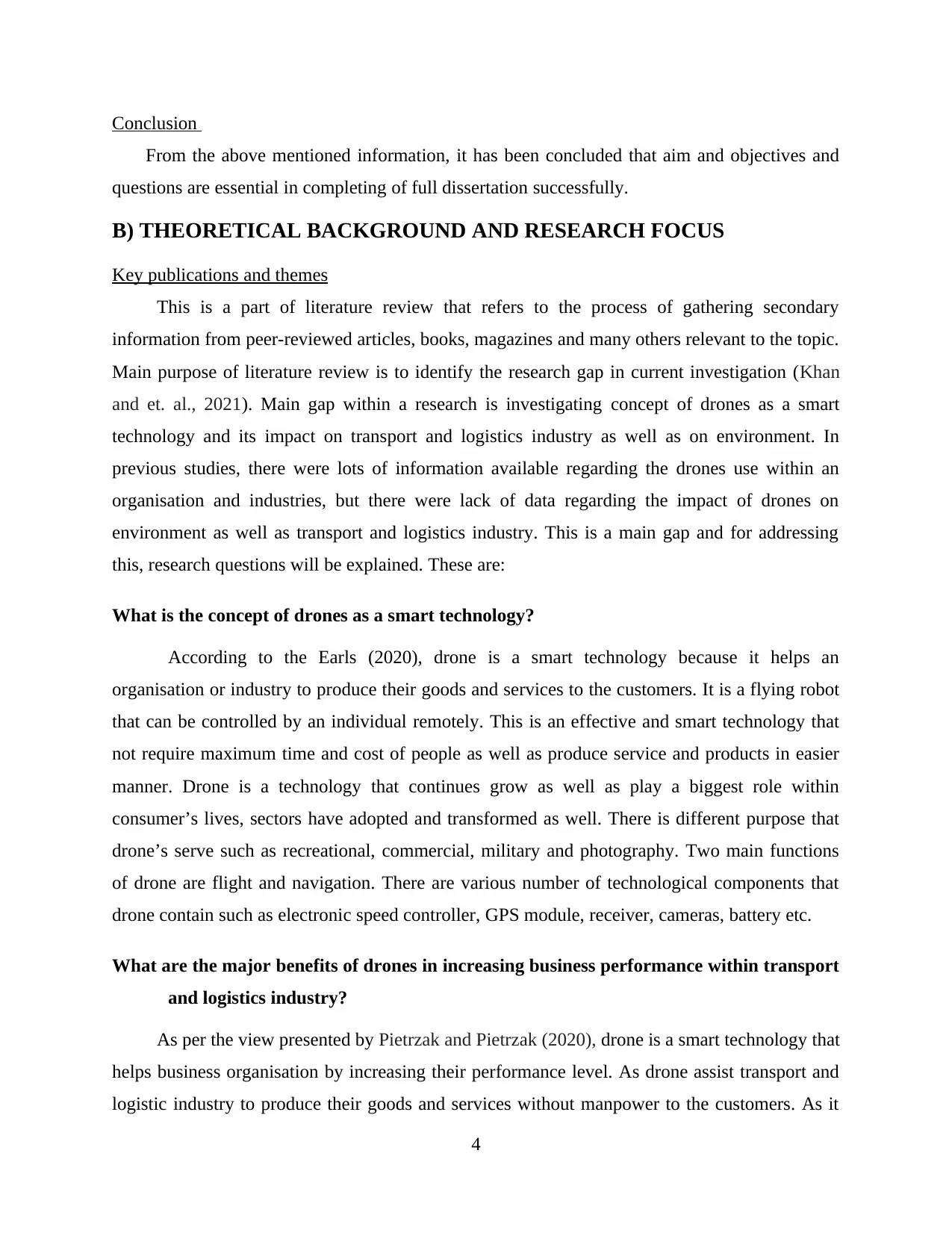
Conclusion
From the above mentioned information, it has been concluded that aim and objectives and
questions are essential in completing of full dissertation successfully.
B) THEORETICAL BACKGROUND AND RESEARCH FOCUS
Key publications and themes
This is a part of literature review that refers to the process of gathering secondary
information from peer-reviewed articles, books, magazines and many others relevant to the topic.
Main purpose of literature review is to identify the research gap in current investigation (Khan
and et. al., 2021). Main gap within a research is investigating concept of drones as a smart
technology and its impact on transport and logistics industry as well as on environment. In
previous studies, there were lots of information available regarding the drones use within an
organisation and industries, but there were lack of data regarding the impact of drones on
environment as well as transport and logistics industry. This is a main gap and for addressing
this, research questions will be explained. These are:
What is the concept of drones as a smart technology?
According to the Earls (2020), drone is a smart technology because it helps an
organisation or industry to produce their goods and services to the customers. It is a flying robot
that can be controlled by an individual remotely. This is an effective and smart technology that
not require maximum time and cost of people as well as produce service and products in easier
manner. Drone is a technology that continues grow as well as play a biggest role within
consumer’s lives, sectors have adopted and transformed as well. There is different purpose that
drone’s serve such as recreational, commercial, military and photography. Two main functions
of drone are flight and navigation. There are various number of technological components that
drone contain such as electronic speed controller, GPS module, receiver, cameras, battery etc.
What are the major benefits of drones in increasing business performance within transport
and logistics industry?
As per the view presented by Pietrzak and Pietrzak (2020), drone is a smart technology that
helps business organisation by increasing their performance level. As drone assist transport and
logistic industry to produce their goods and services without manpower to the customers. As it
4
From the above mentioned information, it has been concluded that aim and objectives and
questions are essential in completing of full dissertation successfully.
B) THEORETICAL BACKGROUND AND RESEARCH FOCUS
Key publications and themes
This is a part of literature review that refers to the process of gathering secondary
information from peer-reviewed articles, books, magazines and many others relevant to the topic.
Main purpose of literature review is to identify the research gap in current investigation (Khan
and et. al., 2021). Main gap within a research is investigating concept of drones as a smart
technology and its impact on transport and logistics industry as well as on environment. In
previous studies, there were lots of information available regarding the drones use within an
organisation and industries, but there were lack of data regarding the impact of drones on
environment as well as transport and logistics industry. This is a main gap and for addressing
this, research questions will be explained. These are:
What is the concept of drones as a smart technology?
According to the Earls (2020), drone is a smart technology because it helps an
organisation or industry to produce their goods and services to the customers. It is a flying robot
that can be controlled by an individual remotely. This is an effective and smart technology that
not require maximum time and cost of people as well as produce service and products in easier
manner. Drone is a technology that continues grow as well as play a biggest role within
consumer’s lives, sectors have adopted and transformed as well. There is different purpose that
drone’s serve such as recreational, commercial, military and photography. Two main functions
of drone are flight and navigation. There are various number of technological components that
drone contain such as electronic speed controller, GPS module, receiver, cameras, battery etc.
What are the major benefits of drones in increasing business performance within transport
and logistics industry?
As per the view presented by Pietrzak and Pietrzak (2020), drone is a smart technology that
helps business organisation by increasing their performance level. As drone assist transport and
logistic industry to produce their goods and services without manpower to the customers. As it
4
Paraphrase This Document
Need a fresh take? Get an instant paraphrase of this document with our AI Paraphraser
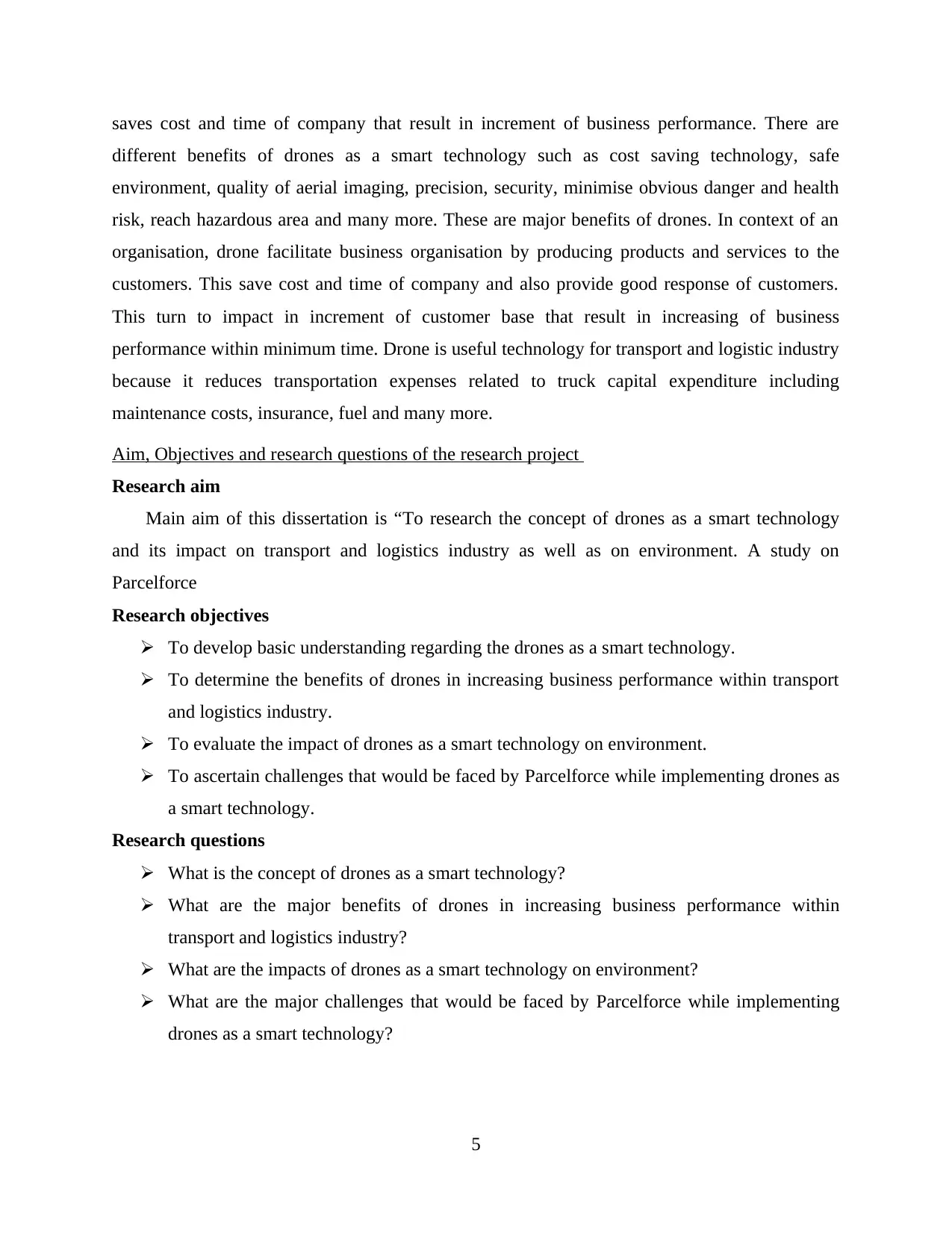
saves cost and time of company that result in increment of business performance. There are
different benefits of drones as a smart technology such as cost saving technology, safe
environment, quality of aerial imaging, precision, security, minimise obvious danger and health
risk, reach hazardous area and many more. These are major benefits of drones. In context of an
organisation, drone facilitate business organisation by producing products and services to the
customers. This save cost and time of company and also provide good response of customers.
This turn to impact in increment of customer base that result in increasing of business
performance within minimum time. Drone is useful technology for transport and logistic industry
because it reduces transportation expenses related to truck capital expenditure including
maintenance costs, insurance, fuel and many more.
Aim, Objectives and research questions of the research project
Research aim
Main aim of this dissertation is “To research the concept of drones as a smart technology
and its impact on transport and logistics industry as well as on environment. A study on
Parcelforce
Research objectives
To develop basic understanding regarding the drones as a smart technology.
To determine the benefits of drones in increasing business performance within transport
and logistics industry.
To evaluate the impact of drones as a smart technology on environment.
To ascertain challenges that would be faced by Parcelforce while implementing drones as
a smart technology.
Research questions
What is the concept of drones as a smart technology?
What are the major benefits of drones in increasing business performance within
transport and logistics industry?
What are the impacts of drones as a smart technology on environment?
What are the major challenges that would be faced by Parcelforce while implementing
drones as a smart technology?
5
different benefits of drones as a smart technology such as cost saving technology, safe
environment, quality of aerial imaging, precision, security, minimise obvious danger and health
risk, reach hazardous area and many more. These are major benefits of drones. In context of an
organisation, drone facilitate business organisation by producing products and services to the
customers. This save cost and time of company and also provide good response of customers.
This turn to impact in increment of customer base that result in increasing of business
performance within minimum time. Drone is useful technology for transport and logistic industry
because it reduces transportation expenses related to truck capital expenditure including
maintenance costs, insurance, fuel and many more.
Aim, Objectives and research questions of the research project
Research aim
Main aim of this dissertation is “To research the concept of drones as a smart technology
and its impact on transport and logistics industry as well as on environment. A study on
Parcelforce
Research objectives
To develop basic understanding regarding the drones as a smart technology.
To determine the benefits of drones in increasing business performance within transport
and logistics industry.
To evaluate the impact of drones as a smart technology on environment.
To ascertain challenges that would be faced by Parcelforce while implementing drones as
a smart technology.
Research questions
What is the concept of drones as a smart technology?
What are the major benefits of drones in increasing business performance within
transport and logistics industry?
What are the impacts of drones as a smart technology on environment?
What are the major challenges that would be faced by Parcelforce while implementing
drones as a smart technology?
5
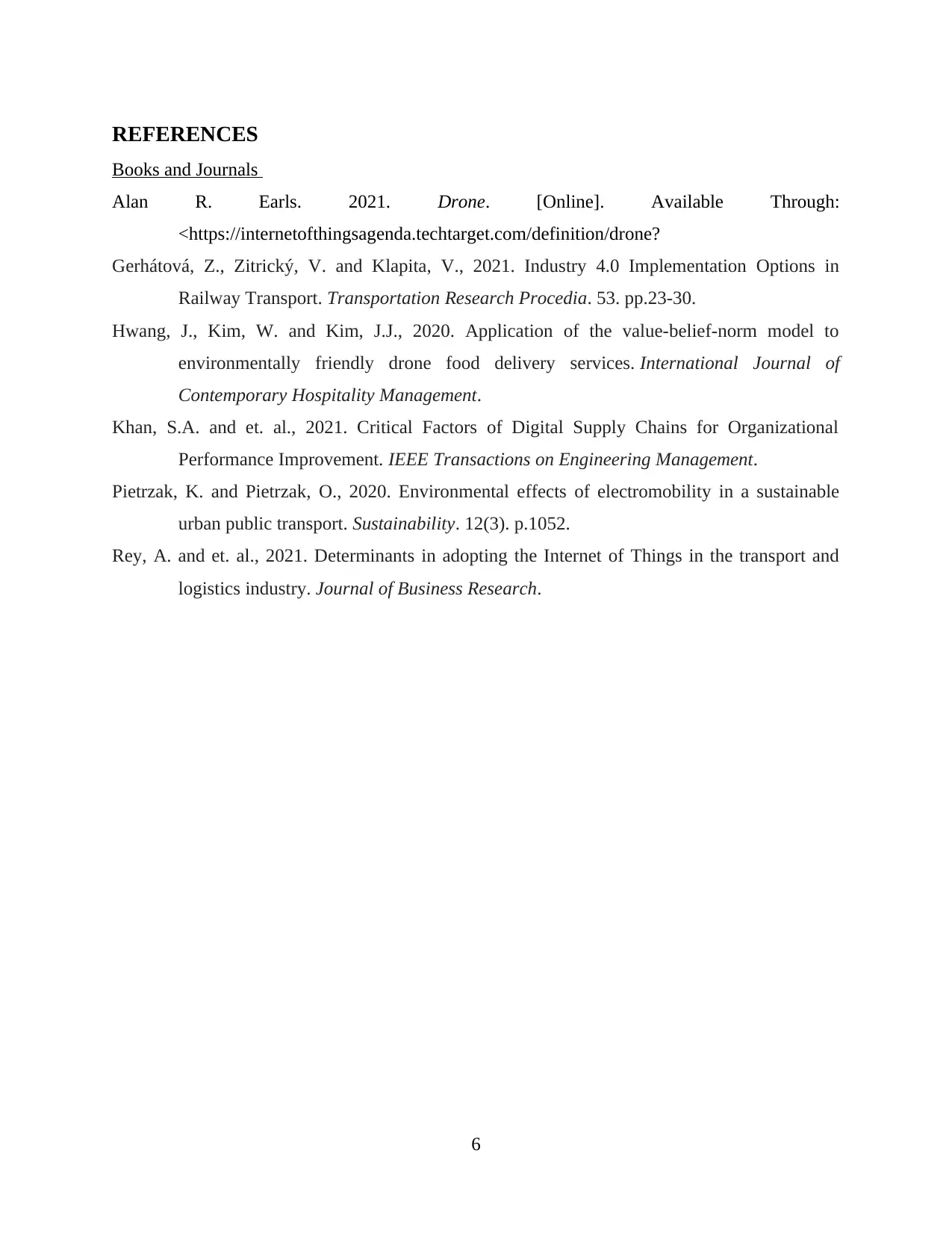
REFERENCES
Books and Journals
Alan R. Earls. 2021. Drone. [Online]. Available Through:
<https://internetofthingsagenda.techtarget.com/definition/drone?
Gerhátová, Z., Zitrický, V. and Klapita, V., 2021. Industry 4.0 Implementation Options in
Railway Transport. Transportation Research Procedia. 53. pp.23-30.
Hwang, J., Kim, W. and Kim, J.J., 2020. Application of the value-belief-norm model to
environmentally friendly drone food delivery services. International Journal of
Contemporary Hospitality Management.
Khan, S.A. and et. al., 2021. Critical Factors of Digital Supply Chains for Organizational
Performance Improvement. IEEE Transactions on Engineering Management.
Pietrzak, K. and Pietrzak, O., 2020. Environmental effects of electromobility in a sustainable
urban public transport. Sustainability. 12(3). p.1052.
Rey, A. and et. al., 2021. Determinants in adopting the Internet of Things in the transport and
logistics industry. Journal of Business Research.
6
Books and Journals
Alan R. Earls. 2021. Drone. [Online]. Available Through:
<https://internetofthingsagenda.techtarget.com/definition/drone?
Gerhátová, Z., Zitrický, V. and Klapita, V., 2021. Industry 4.0 Implementation Options in
Railway Transport. Transportation Research Procedia. 53. pp.23-30.
Hwang, J., Kim, W. and Kim, J.J., 2020. Application of the value-belief-norm model to
environmentally friendly drone food delivery services. International Journal of
Contemporary Hospitality Management.
Khan, S.A. and et. al., 2021. Critical Factors of Digital Supply Chains for Organizational
Performance Improvement. IEEE Transactions on Engineering Management.
Pietrzak, K. and Pietrzak, O., 2020. Environmental effects of electromobility in a sustainable
urban public transport. Sustainability. 12(3). p.1052.
Rey, A. and et. al., 2021. Determinants in adopting the Internet of Things in the transport and
logistics industry. Journal of Business Research.
6
⊘ This is a preview!⊘
Do you want full access?
Subscribe today to unlock all pages.

Trusted by 1+ million students worldwide
1 out of 6
Related Documents
Your All-in-One AI-Powered Toolkit for Academic Success.
+13062052269
info@desklib.com
Available 24*7 on WhatsApp / Email
![[object Object]](/_next/static/media/star-bottom.7253800d.svg)
Unlock your academic potential
Copyright © 2020–2025 A2Z Services. All Rights Reserved. Developed and managed by ZUCOL.





